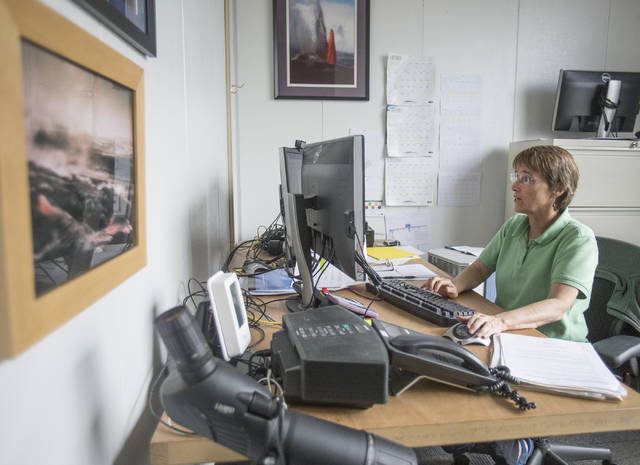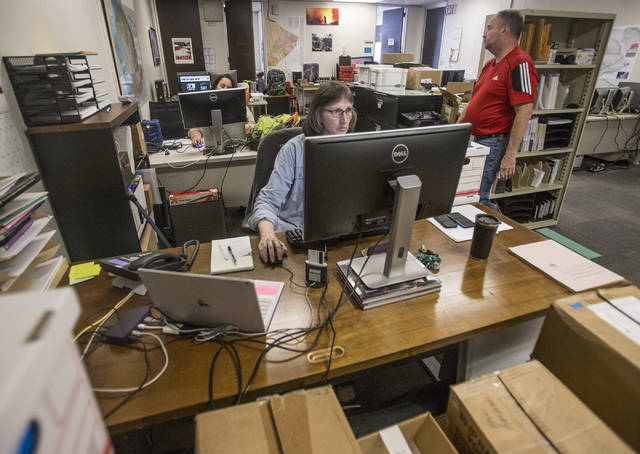The geologists who monitor Hawaii’s volcanoes can still count themselves among those displaced by the recent Kilauea eruption.
The volcano has been the home of scientists since geologist Thomas Jaggar started the first observing station on the rim of Halema‘uma‘u crater in 1912.
Then came the lower East Rift Zone eruption on May 3, which destroyed more than 700 homes in Puna and started a series of collapse events at the summit that prompted the months-long closure of Hawaii Volcanoes National Park and the evacuation of geologists from their Hawaiian Volcano Observatory headquarters next to Jaggar Museum.
Despite having to partially work out of boxes and being spread out at multiple offices in Hilo, the 29 people who work for HVO haven’t missed a beat, said Janet Babb, a geologist and spokeswoman.
“I think we’re managing really well given the circumstances,” she said, noting observations haven’t been interrupted.
“It took some pretty heroic efforts of the IT department that got things moved and set up. All the data is still flowing seamlessly.”
While the eruption came to a stop in September, Babb said it’s still unclear if the geologists can return to their offices on the caldera rim or where another permanent home will be found.
For the time being, the staff are working out of the customs building near Hilo Harbor and offices around the University of Hawaii at Hilo. She said HVO is looking at another rental property in Hilo as a temporary location.
Babb said the HVO facility is badly damaged with cracked floors and walls, collapsed ceilings and offset support beams in the basement.
“We would all love to be back at that location,” she said. “Whether or not that’s going to be possible, remains to be seen.”
The park has said reopening the museum and overlook at that location to the public is highly unlikely. Portions of the park reopened Sept. 22.
HVO’s records are being stored in remote locations, some of which are climate controlled.
Babb said it’s easier for geologists to be stationed at the summit to keep their eyes on the volcano, but it’s possible to monitor it remotely.
“We all loved that location and being in that building,” she said. “It is not necessary for us to be in the building to do our work.”
Babb added there’s talk about what HVO will look like in the coming decades and where it will call its home. But no matter where they are, the work will continue.
“HVO is not a building,” she said. “HVO is the heart of a place. It’s the people that make it.”
Kilauea update
HVO says there is no sign of an imminent eruption on Kilauea since surface lava activity stopped in September.
Inflation continues on the middle East Rift Zone as magma refills the area between Pu‘u ‘O‘o and Highway 130.
One monitoring station detected more than 10 centimeters of inflation in the past two months, which is faster than the inflation rate seen in the buildup to the May 3 eruption.
Babb said that the magma is filling voids left by the eruption and a 6.9-magnitude earthquake. However, the molten rock is not showing signs of “shallowing.”
“We’re not seeing all the geophysical signals we would expect there to be prior to the outbreak of lava,” she said.
That same monitoring station reported subsidence of 50 centimeters during the eruption.
Babb said the volcano is regaining what it lost.
“I think what is happening now is not really a surprise,” she said. “A lot of magma moves through the rift zone and out of the rift zone. Now things are refilling and restabilizing or, of course, the (volcano) is building to the next eruption.”
“We do want to emphasize the possibility is there. It is possible the eruption is not over,” Babb added. “We’re not seeing any imminent signs of that at this time.”
While scientists aren’t calling the eruption officially over, they note that the longer there is no activity at the surface the less likely it is to resume.
Babb said any eruption that happens after three months would likely be considered a new event.
“The thing we have to reinforce,” she said, “is Kilauea is an active volcano, the most active in the U.S. and one of the most active in the world. So we still see signs of magma accumulation in the rift zone. We’re still watching these hot cracks down in the lower East Rift Zone. So we really can’t rule out with certainty eruptive activity in the coming months or years.”
Email Tom Callis at tcallis@hawaiitribune-herald.com.









